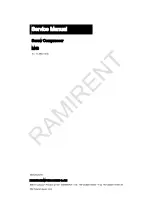
For us, it’s not just business. It’s personal.
SAFETY PRECAUTIONS
Please familiarize yourself with the following information for preventing damage to your air compressor unit and
injury to the operator and/or property damage.
ELECTRICAL HAZARD
Never use the air compressor without connection to a properly grounded outlet with the specifi ed voltage and
fuse protection. Do not use the compressor in a wet or explosive environment, as the electrical components on the
compressor are general purpose and the motors are open drip proof. The compressor must be located a minimum of
20 feet (6.1 metres) from any source of potentially explosive vapours. Never attempt maintenance or adjustment with
power connected or while the equipment is in operation.
TANK SAFETY VALVE
The safety valve is factory installed to prevent the air receiver from damage should malfunction occur in the pressure
switch. It is factory set at a specifi c limit for your particular model, and should never be tampered with. Adjustment by
user will automatically void warranty.
PRESSURE SWITCH
The air compressor switch is set at the factory for optimum performance of your particular model. Never bypass or
remove this switch as serious damage to equipment or personal injury could result from too high of pressure.
MOTOR AND COMPRESSOR PUMP
Air compressors become hot while in operation. Never touch the motor, compressor pump, and/or discharge tubing while
in operation or immediately after operation. Touching these areas may cause severe burns. The compressor automatically
operates while the power is on. Do not come into contact with moving parts. Shut off all power to the unit before
attempting to repair or maintain the compressor. Never operate the compressor with the belt guard removed.
COMPRESSED AIR CAUTION
Compressed air from the unit may contain poisonous vapours which are not suitable for inhaling and could be
harmful to your health. Never directly inhale compressed air produced by the compressor. Always use proper fi ltration,
carbon monoxide monitor and quality tested air for breathing applications from a compressor. Ensure your breathing
apparatus meets NIOSH and OSHA requirements. Always wear proper safety equipment while using compressed air.
AIR RECEIVER
Over pressurizing the air receiver could cause an explosion or rupture. To protect from over pressurizing a factory
preset safety valve is included. Do not remove, make adjustments or substitutions for this valve. Occasionally pull the
ring on the valve to make sure that the valve operates freely. If the valve does not operate freely, it must be replaced.
Never weld to, drill, or change the air receiver in any way. If any of the above conditions are changed or tampered with
this may result in voiding of the manufacturer’s warranty.
GENERAL DESCRIPTION OF AIR COMPRESSOR
To compress air, the piston moves up and down in the cylinder. During the downstroke, air is drawn in through the
inlet valve. The discharge valve remains closed. During the upstroke of the piston, air is compressed. The inlet valve
closes and compressed air is forced out through the discharge valve, through the discharge tube, through the check
valve and into the air receiver. Working air is not available until the compressor has raised the air receiver pressure
above the requirement at the air service connection. The air inlet fi lter openings must be kept clear of obstructions.
1
Summary of Contents for TK-5080V
Page 11: ...9 MAINTENANCE LOG CHART...






























